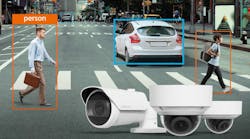In today's modern world, video surveillance has quietly integrated into our everyday life. It monitors our daily commutes, workspaces, shopping trips and even health practices. There is no denying that the advancement of AI-powered surveillance and video analytics tools have proven to be an effective safeguard for organizations’ critical infrastructure.
But while video can offer benefits such as improved security and operational efficiency, it also raises important privacy concerns in the United States, where different states have varying laws and there is no singular framework that protects the privacy of all types of personal data. As a result, organizations that collect video data are left to navigate a challenging regulatory landscape as legislators face increasingly loud demands from Americans for more extensive protections.
Public mistrust is growing towards facial recognition and monitoring technology due, in part, to misuse by certain entities. The good news is that with more advanced video solutions, also comes new opportunities to harness the technology to protect data. AI-powered data redaction technology can effectively remove personal information within video content, such as faces or vehicle registrations at-scale, allowing organizations to utilize video data without violating privacy expectations. This not only fosters public trust but also helps maintain compliance with complex and evolving data protection laws.
How At-Scale AI Video Redaction Works
An hour of CCTV in busy public locations can contain upwards of two million faces. Manually redacting every image of personal data from every frame is an expensive, boring, and difficult task that requires considerable attention to detail and can take users days or even weeks to complete.
Cutting-edge video redaction tools use the latest machine learning and computer vision approaches to train their algorithms to recognize personal identifiable information (PII) in a wide variety of image and video scenes. This automated, scaled approach can make redaction two hundred times faster than traditional methods - enabling organizations to be far more efficient and accurate when it comes to anonymizing video footage, opening new opportunities for the use of CCTV, body-worn and dash cam video.
Privacy enhancing technologies (PETs) recognize personal identifiers (such as faces, heads and number plates) as a human observer would anonymize information automatically. It can be deployed selectively, so some specific or all faces are removed, and/or all vehicle registration details or other identifying information.
Application of Video Data Redaction Across Industries
This critical balance between surveillance and privacy echoes across many sectors.
In healthcare, particularly during clinical trials, visual documentation is pivotal. To protect patient privacy while validating treatment efficacy, redaction is used before submitting videos to regulatory bodies like the FDA. This not only ensures patient privacy but can also potentially circumvent time-consuming retrials if new queries emerge post-trial. Hospital settings also employ video surveillance to maintain physical security and ensure patient safety. Redaction and anonymization of live video allow critical environments to be monitored without infringing upon privacy rights.
The need for this technology can also be seen with the growing integration of digital learning and video usage in our education system, requiring responsible video data handling. As student information is often captured both on various devices during online classes and in the physical school setting, face and identity anonymization technology can provide critical protection. This not only safeguards the privacy of minors but allows institutions to share video data responsibly with parents, staff and other third parties.Public safety and law enforcement are heavy users of video surveillance. Redaction technology enhances productivity and reduces costs, while anonymized live video allows responsible monitoring, ensuring the necessary data is accessed only when something significant occurs.
Similarly, in the transport and logistics industry, redaction helps handle video data efficiently for incident investigations and anonymized video analytics, thereby enhancing operational management for station concourses and transport networks.
And of course, any retail business relies on surveillance for loss prevention, safety and security and operational efficiency. Data redaction in this setting can be used to manage incidents responsibly while fostering ethical operations. With this technology, retailers can analyze anonymized data to enhance operations without risking a breach of personal privacy.
The Rising Tide of Data Privacy
Video data collectors often face requests for the removal of identifiable data, necessitating robust redaction processes, and as data privacy regulations become more comprehensive globally, protecting personal data has become increasingly crucial. According to the International Association of Privacy Professionals (IAAP), which monitors active state-by-state data privacy legislation, “state-level momentum for comprehensive privacy bills is at an all-time high” in the US, where data anonymization is required for compliance with privacy laws such as HIPAA, COPPA and HITECH, as well as for FDA approvals in the clinical research setting. Anonymization is not only recommended by the UK Information Commissioner's Office (ICO) and European data protection agencies but also serves as a viable solution for legal and practical security.
In a world teeming with video surveillance, video data redaction is a strategic tool that allows for efficient operations, safeguards businesses from non-compliance penalties, and upholds individual privacy rights. Amidst this intersection of technology and privacy, securing personal data is not a luxury; it is a fundamental necessity. Video data redaction is not merely about technology or regulatory compliance — it is about preserving our fundamental rights to privacy in a rapidly evolving digital landscape.





